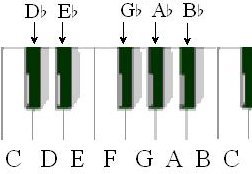Pentatonic Scale
chromatic scales - blues scale - pentatonic scale
The pentatonic scale is arguably one of the most widely used scales in music. It can be found in just about all ancient and contemporary cultures, including Celtic folk music, Hungarian folk music, African-American spirituals, Gospel music, American folk music, Jazz, American blues music, rock music and many more.
The pentatonic is a 5 note scale as opposed to the more traditional major and minor scales, which contain all 7 notes of the musical alphabet (or the 12 note chromatic scale.)
Pentatonics are closely related to the traditional major and minor scales. They can also be major or minor.
Major Pentatonic Scales
Major pentatonic scales are basically major scales without the 4th and 7th scale steps: 1-2-3-5-6-(8-1) So a C major pentatonic would be: C-D-E-G-A-C
Here is a C major scale and a C major pentatonic:

The 4th and 7th steps of the seven note major scale have very strong tendencies to resolve; the 4th wants to resolve to the 3rd and the 7th wants to go to the tonic. By omitting these strong, dominant tones, the pentatonic achieves a total lack of the most dissonant intervals between any pitches; there are no minor seconds, major sevenths or tritones. This means any note can be played in any order or combination without clashing. This makes it much easier to manipulate the notes when improvising or writing melodies.
Here are some other major pentatonic scales:

If you have ever played around with or tried improvising with just the black keys on a piano, you have been playing with a Gb major pentatonic: Gb-Ab-Bb-Db-Eb

Many popular melodies are based on this five note scale. The first 2 phrases of Stephen Foster's "Oh! Susanna" are based on a major pentatonic:

Minor Pentatonic Scales
The minor pentatonic is basically the natural minor scale minus the 2nd and 6th scale steps.
Here are the C natural minor scale and C minor pentatonic:

Note that the minor pentatonic does use the 4th and 7th steps of the natural minor scale. This is because they are a whole step from the 3rd and tonic and don't have the same strong resolution tendency as the half steps in the major. However, the 2nd and 6th steps are omitted because they are a 1/2 step from the 3rd and 5th. By eliminating the more dissonant half steps, the minor pentatonic has a similar quality and function as the minor scale and the popular blues scale.
This is an ideal, straightforward scale for blues improvisation.

Click here to GO BACK TO SCALES.
THE COMPLETE
ONLINE BUSINESS BUILDER
SBI
Hi and Welcome!
Fill out the form below to sign up for the free periodic
Player's Guide Newsletter!
Get tips and ideas about substitute chords, chord progressions and harmonic movement.
What's this???




New! Comments
Please leave me a comment in the box below.